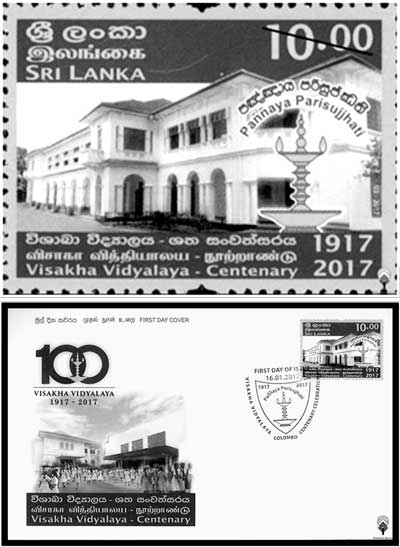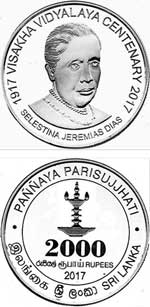Tuesday Dec 09, 2025
Tuesday Dec 09, 2025
Saturday, 18 February 2017 00:00 - - {{hitsCtrl.values.hits}}
A centenary is a significant milestone for any institution. It’s even more noteworthy when it happens to be a school which, over a hundred years, would have produced thousands of useful citizens.
Year 2017 is the Centenary Year of Sri Lanka’s leading Buddhist school, Visakha Vidyalaya. A commemorative stamp along with the First Day Cover was released on 16 January, the Founder’s Day of the school.
In the wake of the Buddhist revivalist movement, the first Buddhist girls’ school was established thanks to the generosity of a lady from Panadura, Jeremias Dias. (Her maiden name was Selestina Rodrigo.) The school was in memory of her late son, Bertie Wilson Dias. 
She took on lease ‘The Firs’, a spacious old house in Turret Road (now Anagarika Dharmapala Mawatha) and set up the Buddhist Girls’ College under an American principal, Dr. Bernice Banning MA, PhD with 20 pupils, daughters of Buddhist parents.
The wealthy lady set up a Trust with another Buddhist philanthropist and patriot, Dr. W.A. de Silva as Trustee. She donated ‘Good Hope’, a rubber estate in the Kalutara District and the school was to be managed with its income. Dr. de Silva was appointed manager.
One of the first pupils, Maisie de Silva describes how at 8 a.m. on the opening day the Principal Miss Banning “stood before us immaculate in white, serene and saintly, to conduct ‘Pansil’. The whole assembly then read together the Mangala and Metta Suttas.”
She adds: “After assembly we found ourselves in classes berthed in garages, out-houses and thatched sheds. Yet with great expectancy and enthusiasm we settled down to earnest work.”
The children were encouraged to observe ‘ata-sil’ on Poya days and the hostellers were taken to the Gangaramaya on Sundays.
Accepting that knowing English was a valuable social asset, classes were conducted in English. In addition to studies in the normal subjects, music, painting, modelling and eurhythmics were taught.
Dr. de Silva who was a Trustee relinquished his duties after three years and a Board of Trust was formed by Jeremias Dias in 1920 comprising D.B. Jayatilake, D.S. Senanayake and Thomas de Silva. D.B. Jayatilaka was appointed manager in which capacity he served for 19 years.
The school which had classes up to Grade 8 was registered as an Assisted School in October 1920 and as a Secondary School with Junior Cambridge classes in October 1921.
With the gradual expansion of the school Mrs. Dias realised that it needed more space and bought a three-acre block at Vajira Road, Bambalapitiya and she herself laid the foundation stone for a new building in 1926. British Governor Sir Herbert Stanley opened it in the following year. The name was changed and ‘Visakha Vidyalaya’ was born.
It is reported that Vajira Road was then a narrow road where only a rickshaw could go.
Constant change of principals was a feature in the early days when there were seven principals during the first eight years. Gradually the situation improved and the school progressed under those who served for longer periods.
Note: The release of the stamp was apparently the result of a special request by President Maithripala Sirisena. With so many schools reaching the century landmark the Philatelic Bureau had stopped the release of centenary stamps in 2014. Following up on a request by Visakha Vidyalaya the President had checked the position and when he was informed that there was no ruling by the Ministry of Education, he had suggested the issue of the stamp.
Meanwhile, the Central Bank released a commemorative Rs. 2,000 gold embossed, sterling silver frosted coin. The selling price is Rs. 12,000 and with only 1,000 coins being available, they are being bought up by well-wishers and coin collectors.